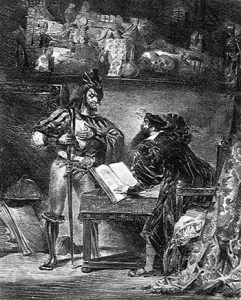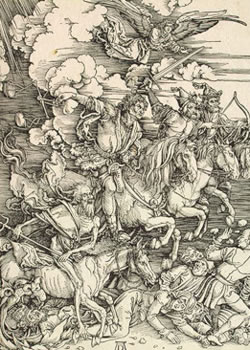Eugene Delacroix – Goethe’s Faust lithographs
 In the 1820s, the artist Eugene Delacroix was in the prime of his creative power. He is 30 years old, he is a recognized master, who created the paintings that put him among the best artists of France: “Dante and Virgil”, “The Massacre at Chios”, “The Execution of Marino Falyero”, “The Death of Sardanapala”.
In the 1820s, the artist Eugene Delacroix was in the prime of his creative power. He is 30 years old, he is a recognized master, who created the paintings that put him among the best artists of France: “Dante and Virgil”, “The Massacre at Chios”, “The Execution of Marino Falyero”, “The Death of Sardanapala”.
In them, Delacroix most fully reflected the ideas of progressive romanticism that prevailed at that time in French painting, to the transmission of historical truth, expressed by a bright, emotional language, which compels the emperor to sympathize with the characters, strong, whole and passionate.
In 1828, the artist performed a cycle of lithographs on the theme of “Faust” by I.-V. Goethe. In them, he appeared the same romantic as in painting.
Lithographs to “Faust” – one of the most original phenomena in the work of Delacroix. They were released as a separate edition in 1828. The artist immediately sent Goethe a copy of the Paris edition. The great writer praised the illustrations and even said that the interpretation of some scenes is richer than his own.
Delacroix was often accused of “literary”, denied his art in the name of “pure painting.” The master himself said that the artists of the New Time are occupied almost exclusively by the beauty and character of brush strokes, and they consider everything else in the painting to be something outside painting.
But such an appeal to literary sources is associated with the idea of synthesis of arts in romanticism. The desire to unite various arts is one of the main problems of aesthetics of this direction. The relationship of literature with music was manifested in the saturation of poetry with musical rhythms and intonations. Literary images, plots, themes penetrate music. Conversely, some paintings of the beginning of the XIX century were built according to the laws of music. So, the picture of the famous German romance M. Schwind “The Symphony” consisted of four parts with musical names. The largest German romantic writer Novalis believed that a plastic work of art should never be watched without music, and music, on the contrary, should be listened to in beautifully decorated halls. Poetry, according to Novalis, should be enjoyed with one and the other.
It is known that Delacroix created monumental canvases to the sounds of organ and choral, which acted inspiringly on him. Many masters of romanticism vividly revealed themselves in various forms of art. So, the writer E.-T.-A. Hoffmann was, in addition, a painter and composer. His opera “Ondine” was a great success with his contemporaries. Victor Hugo, in addition to the great novels, created the most original drawings. Delacroix was also a gifted writer, he left “The Diaries” – a remarkable literary work that combines an epistolary genre, a lyrical description, an apt and sharp comparison, a subtle essay, and a philosophical generalization.
The very art of Delacroix demanded an appeal to literary topics. His artistic interpretation almost merges with the works of the classics, which were a source of inspiration for him.
On June 9, 1823, he writes in his diary: “Why not resort to antidotes of civilization, to good books? They strengthen the soul and give it peace. ” And on April 11, 1824, another record, as if continuing the first one: “What should be done to find the plot? Open a book that can inspire and trust your mood! There are books that always have an effect. They are something like prints, and you need to have on hand. This – Dante, Lamartine, Byron, Michelangelo.
Their need for strong feelings, bright and integral characters, extraordinary themes of romance drew from literary sources. Literature gave impetus to the powerful imagination of Delacroix. However, literary plots were only external canvas, and the decision belonged to the artist himself, who never forgot that “nature is the dictionary according to which the artist makes sentences”. His works often expanded and supplemented the original, revealing new, unexpected aspects. Especially fascinated are the masters of Dante, Ariosto, Tasso, Shakespeare, Byron, Milton, Walter Scott and Goethe.
In 1825 he became acquainted with Goethe’s Faust, under whose influence he created many drawings and lithographs. Delacroix knew at that time only the first part of the work, since the second was not yet complete. Nevertheless, the fantasies of romance opened up wide open spaces here: medieval Germany, an extraordinary plot, an action, then locked in an alchemist’s closet room, then unfolding in the wild rampage of Walpurgis Night.


